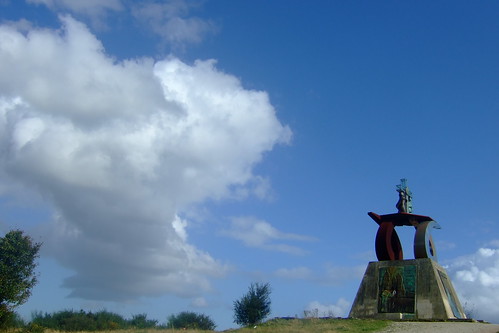
Tired, sweaty, drowsy, facing the steep slope of the Via Sacra, which runs along the wall of the Convent of San Paio Antealtares. Raise our view. There it is! Our goal, the magic moment for which we have struggled in recent days. Quite a few days walking, the foot injury, the body slumped in the marches exhausting. But at last our eyes are closed the culmination of our dream: the Cathedral, the epilogue of our Camino de Santiago.
Because nothing better to contemplate Santiago to climb the Monte do Gozo, where medieval pilgrims chanting the Te Deum in view of the skyline of the city. From there, five miles separate us from the porch. From there, the president of St. Peter will take us until the best known of Santiago: the Porta do Caminho, one of the seven entries that had the ancient wall. So cross surprised that a city changes over the streets, because Santiago is clearly divided in two: the new part of the former. A vital, and youthful atmosphere of authentic historical virtually taken over by the pilgrims.

Rua das Casas Reais, Rua das mood, and finally Azabachería of the Via Sacra to meet the magical ritual visit to the Apostle. And there, in the Plaza de Quintana, rejuvenates heart, forget the weariness, smiles again, because a stone’s throw away is the Plaza del Obradoiro, the cloak that gives access to the most beautiful baroque facade can imagine that being humans.
Since the appearance of the apostle and 1200 years ago, the flood of pilgrims was such that the clergy did take advantage of such beliefs, and at the same time, the city to deliver a profound transformation. It was the eighteenth century which was the last one, which encouraged the Church to build a facade to match the popular fervor. Such is the grandeur of its facade, as big and beautiful and the piazza Obradoiro who really do not know what was built to expand to the other.
Obradoiro Plaza is the noble, beautiful, great, and the tails of waiting pilgrims perform the ritual no less long enduring under the sky of the square is uncovered sun or rain. To the west of them, Raxoi Palace, a huge neoclassical building built in 1767 for placing children in the choir of the Cathedral, and today, home of the City Council and the Xunta de Galicia, whose capital is Santiago. To the south lies the San Xerome gothic stately home, where the Rector of the University, and in front of him, the Royal Hospital, built in the year 1501, granted by the Catholic Kings, and today, Parade of Tourism.
But what really fills the soul are those steps that every pilgrim boasts having risen once in their life. With each step Restall silence of the steps. With each step, silent heartbeat, rises out of sight and the wonderful stone Portico de la Gloria whisper in our ears the nostalgic sounds of the centuries of history.
It was in 1100 when Bishop Xelmírez commissioned a mason, Matthew, a new door for the church of Compostela. And one of his workshop was wonderful Romanesque arch-shaped with 24 figures, the Apocalypse of the elders of the cut and wrapped him in a Christ and his apostles in relief. Under it, the figure of an apostle of the cozy Santiago pilgrims.

There are still many things to see in Santiago de Compostela, Xelmírez as the Palace, in Romanesque style, or the Monastery of Saint Martin Pinario or Hostal de los Reyes Catholics, and many adventures to live on the night of Compostela, in the old town where there are many places with a special decoration and quiet music, or in the famous widening area, the march to Santiago …
One Response to “Santiago de Compostela, the final stage in the route of Santiago”
Leave a Reply
You must be logged in to post a comment.
julio 11th, 2009 at 12:25 am
[…] More here http://www.villadeayora.com/blog […]